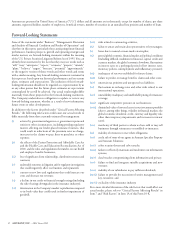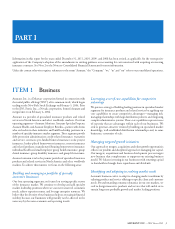Assurant 2012 Annual Report Download - page 20
Download and view the complete annual report
Please find page 20 of the 2012 Assurant annual report below. You can navigate through the pages in the report by either clicking on the pages listed below, or by using the keyword search tool below to find specific information within the annual report.ASSURANT, INC.2012 Form10-K12
PARTI
ITEM 1 Business
Market Conduct Regulation
Activities of insurers are highly regulated by state insurance laws
and regulations, which govern the form and content of disclosure to
consumers, advertising, sales practices and complaint handling. State
regulatory authorities enforce compliance through periodic market
conduct examinations.
Guaranty Associations and Indemnity Funds
Most states require insurance companies to support guaranty associations
or indemnity funds, which are established to pay claims on behalf of
insolvent insurance companies. ese associations may levy assessments
on member insurers. In some states member insurers can recover
a portion of these assessments through premium tax o sets and/or
policyholder surcharges.
Insurance Regulatory Initiatives
e NAIC, state regulators and professional organizations have considered
and are considering various proposals that may alter or increase state
authority to regulate insurance companies and insurance holding
companies. Please see Item1A, “Risk Factors—Risks Related to Our
Industry—Changes in regulation may reduce our pro tability and
limit our growth” for a discussion of the risks related to such initiatives.
Federal Regulation
Patient Protection and Aff ordable Care Act
Although health insurance is generally regulated at the state level,
recent legislative actions were taken at the federal level that impose
added restrictions on our business, in particular Assurant Health and
Assurant Employee Bene ts. In March2010, President Obama signed
the A ordable Care Act into law. Provisions of the A ordable Care
Act and related reforms have and will continue to become e ective at
various dates over the next several years. ese provisions and related
impacts include a requirement that we pay premium rebates to customers
if the loss ratios for some of our product lines are less than speci ed
percentages; the reduction of agent commissions, and the consequent
risk that insurance producers may sell less of our products than they
have in the past; changes in the bene ts provided under some of our
products; elimination of limits on lifetime and annual bene t maximums;
a prohibition from imposing any pre-existing condition exclusion as it
applies to enrollees under the age of 19 who apply for coverage; limits
on our ability to rescind coverage for persons who have misrepresented
or omitted material information when they applied for coverage and,
after January1, 2014, elimination of our ability to underwrite health
insurance products with certain narrow exceptions; a requirement to
o er coverage to any person who applies for such coverage; requirements
to include the package of essential health bene ts; increased costs to
modify and/or sell our products; intensi ed competitive pressures that
limit our ability to increase rates due to state insurance exchanges;
signi cant risk of customer loss; new and higher taxes and fees and
limitations on the deductibility of compensation and certain other
payments; and the need to operate with a lower expense structure at
both the business segment and enterprise level.
Employee Retirement Income Security Act
Because we provide products and services for certain U.S. employee
bene t plans, we are subject to regulation under the Employee Retirement
Income Security Act of 1974, as amended (“ERISA”). ERISA places
certain requirements on how the Company may do business with
employers that maintain employee bene t plans covered by ERISA.
Among other things, regulations under ERISA set standards for certain
notice and disclosure requirements and for claim processing and appeals.
In addition, some of our administrative services and other activities
may also be subject to regulation under ERISA.
HIPAA, HITECH Act and Gramm-Leach-Bliley Act
e Health Insurance Portability and Accountability Act of 1996, along
with its implementing regulations (“HIPAA”), impose various requirements
on health insurers, HMOs, health plans and health care providers.
Among other things, Assurant Health and Assurant Employee Bene ts
are subject to HIPAA regulations requiring certain guaranteed issuance
and renewability of health insurance coverage for individuals and small
groups (generally groups with 50 or fewer employees) and limitations
on exclusions based on pre-existing conditions. HIPAA also imposes
administrative simpli cation requirements for electronic transactions.
HIPAA also imposes requirements on health insurers, health plans and
health care providers to ensure the privacy and security of protected
health information. ese privacy and security provisions were further
expanded by the privacy provisions contained in the Health Information
Technology for Economic and Clinical Health Act (the “HITECH Act”)
and its accompanying Omnibus Rule enacted in January2013, which
enhances penalties for violations of HIPAA and requires regulated entities
to provide notice of security breaches of protected health information
to individuals and HHS. In addition, certain of our activities are subject
to the privacy regulations of the Gramm-Leach-Bliley Act, which, along
with regulations adopted thereunder, generally requires insurers to
provide customers with notice regarding how their non-public personal
health and nancial information is used, and to provide them with the
opportunity to “opt out” of certain disclosures, if applicable.
Dodd-Frank Wall Street Reform and Consumer
Protection Act
In July2010, President Obama signed into law the Dodd-Frank
Wall Street Reform and Consumer Protection Act (the “Dodd-Frank
Act”), which implements comprehensive changes to the regulation of
nancial services in the U.S. Among other things, Congress created
the Consumer Financial Protection Bureau (the “CFPB”). While the
CFPB does not have direct jurisdiction over insurance products, it is
possible that regulations promulgated by the CFPB may extend its
authority more broadly to cover these products and thereby a ect the
Company or our clients.
In addition, the Dodd-Frank Act establishes a Federal Insurance O ce
within the Department of the Treasury, headed by a director appointed
by the Secretary of the Treasury. While not having a general supervisory
or regulatory authority over the business of insurance, the director of
this o ce performs various functions with respect to insurance (other
than health insurance) and is required to conduct a study on how to
modernize and improve the system of insurance regulation in the U.S.,
including by increased national uniformity through either a federal
charter or e ective action by the states.
























